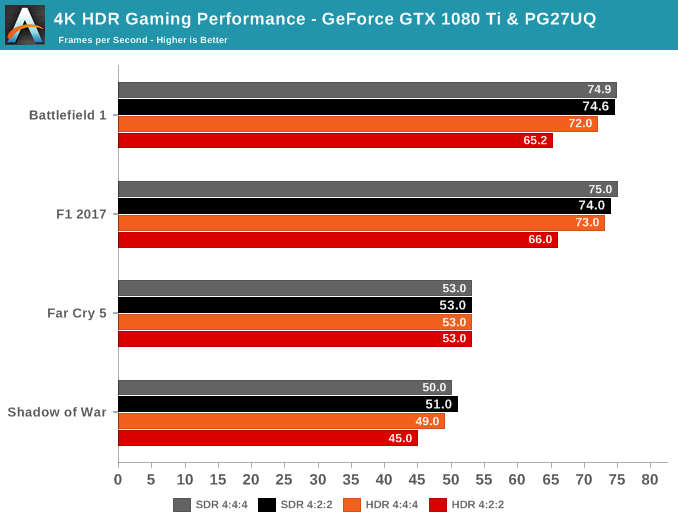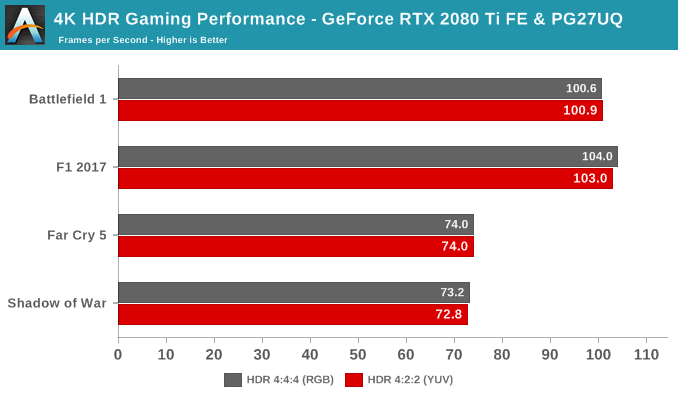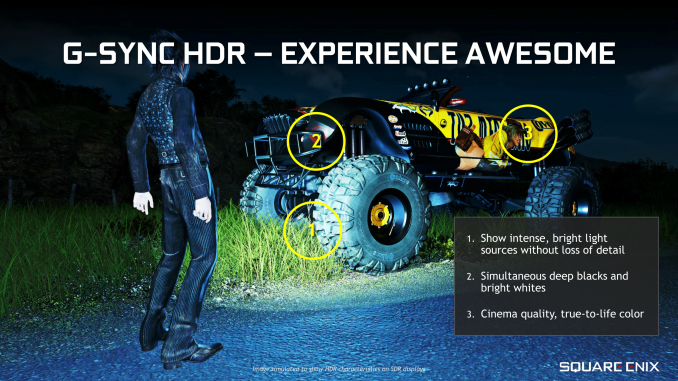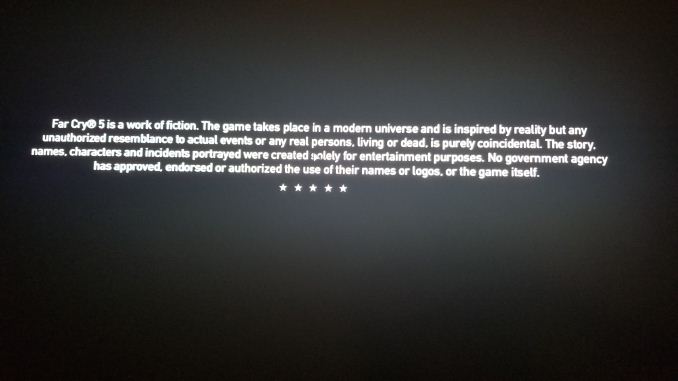The Asus ROG Swift PG27UQ G-SYNC HDR Monitor Review: Gaming With All The Bells and Whistles
by Nate Oh on October 2, 2018 10:00 AM EST- Posted in
- Monitors
- Displays
- Asus
- NVIDIA
- G-Sync
- PG27UQ
- ROG Swift PG27UQ
- G-Sync HDR
HDR Gaming Impressions
In the end, a monitor like the PG27UQ is really destined for one purpose: gaming. And not just any gaming, but the type of quality experience that does not compromise between resolution and refresh rate, let alone HDR and VRR.
That being said, not many games support HDR, which for G-Sync HDR means HDR10 support. Even for games that do support an HDR standard of some kind, the quality of the implementation naturally varies from developer to developer. And because of console HDR support, some games only feature HDR in their console incarnations.
The other issue is that the HDR gaming experience is hard to communicate objectively. In-game screenshots won't replicate how the HDR content is delivered on the monitor with its brightness, backlighting, and wider color gamut, while photographs are naturally limited by the capturing device. And naturally, any HDR content will obviously be limited by the viewer's display. On our side, this makes it easy to generally gush about glorious HDR vibrance and brightness, especially as on-the-fly blind A/B testing is not so simple (duplicated SDR and HDR output is not currently possible).
As for today, we are looking at Far Cry 5 (HDR10), F1 2017 (scRGB HDR), Battlefield 1 (HDR10), and Middle-earth: Shadow of War (HDR10), which covers a good mix of genres and graphics intensity. Thanks to in-game benchmarks for three of them, they also provide a static point of reference; in the same vein, Battlefield 1's presence in the GPU game suite means I've seen and benchmarked the same sequence enough times to dream about it.
For such subjective-but-necessary impressions like these, we'll keep ourselves grounded by sticking to a few broad questions:
- What differences are noticable from 4K with non-HDR G-Sync?
- What differences are noticable from 4:4:4 to 4:2:2 chroma subsampling at 98Hz?
- What about lowering resolution to 1440p HDR or lowering details with HDR on, for higher refresh rates? Do I prefer HDR over high refresh rates?
- Are there any HDR artifacts? e.g. halo effects, washed out or garish colors, blooming due to local dimming
The 4K G-Sync HDR Experience
From the beginning, we expected that targeting 144fps at 4K was not really plausible for graphically intense games, and that still holds true. On a reference GeForce GTX 1080 Ti, none of the games averaged past 75fps, and even the brand-new RTX 2080 Ti won't come close to doubling that.
Ubquituous black loading and intro screens make the local dimming bloom easily noticable, though this is a commonly known phenomenon and somewhat unavoidable. The majority of the time, it is fairly unintrusive. Because the local backlighting zones can only get so small on LCD displays – in the case of this monitor, each zone is roughly 5.2cm2 in area – anything that is smaller than the zone will still be lit up across the zone. For example, a logo or loading throbber on a black background will have a visible glow around them. The issue is not specific to the PG27UQ, only that higher maximum brightness makes it little more obvious. One of the answers to this is OLED, where subpixels are self-emitting and thus lighting can be controlled on an individual subpixel basis, but because of burn-in it's not suitable for PCs.


Loading throbbers for Shadow of War (left) and Far Cry 5 (right) with the FALD haloing effect
Much has been said about describing the sheer brightness range, but the closest analogy that comes to mind is like dialing up smartphone brightness to maximum after a day of nursing a low battery on 10% brightness. It's still up to the game to take full advantage of it with HDR10 or scRGB. Some games will also offer to set gamma, maximum brightness, and/or reference white levels, thereby allowing you to adjust the HDR settings to the brightness capability of the HDR monitor.
The most immediate takeaway is the additional brightness and how fast it can ramp up. The former has a tendency to make things more clear and colorful - the Hunt effect in play, essentially. The latter is very noticable in transitions, such as sudden sunlight, looking up to the sky, and changes in lighting. Of course, the extra color vividness works hand-in-hand with the better contrast ratios, but again this can be game- and scene-dependent; Far Cry 5 seemed to fare the best in that respect, though Shadow of War, Battlefield 1, and F1 2017 still looked better than in SDR.
In-game, I couldn't perceive any quality differences going from 4:4:4 to 4:2:2 chroma subsampling, though the games couldn't reach past 98Hz at 4K anyway. So at 50 to 70fps averages, the experience reminded me more of a 'cinematic' experience, because HDR made the scenes look more realistic and brighter while the gameplay was the typical pseudo 60fps VRR experience. With that in mind, it would probably be better for exploration-heavy games where you would 'stop-and-look' a lot - and unfortunately, we don't have Final Fantasy XV at the moment to try out. NVIDIA themselves say that increased luminance actually increases the perception of judder at low refresh rates, but luckily the presence of VRR would be mitigating judder in the first place.

What was interesting to observe was a performance impact with HDR enabled (and with G-Sync off) on the GeForce GTX 1080 Ti, which seems to corroborate last month's findings by ComputerBase.de. For the GTX 1080 Ti, Far Cry 5 was generally unaffected, but Battlefield 1 and F1 2017 took clear performance hits, appearing to stem from 4:2:2 chroma subsampling on HDR (YCbCr422). Shadow of War also seemed to fare worse. Our early results also indicate that even HDR with 4:4:4 chroma subsampling (RGB444) may result in a slight performance hit in affected games.
It's not clear what the root cause is, and we'll be digging deeper as we revisit the GeForce RTX 20-series. Taking a glance at the RTX 2080 Ti Founders Editions, the performance hit of 4:2:2 subsampling is reduced to negligable margins in these four games.

On Asus' side, the monitor does everything that it is asked of: it comfortably reaches 1000 nits, and as long as FALD backlighting is enabled, the IPS backlight bleed is pretty much non-existent. There was no observed ghosting or other artifacts of the like.
The other aspects of the HDR gaming 'playflow' is that enabling HDR can be slightly different per game and Alt-Tabbing is hit-or-miss - that is on Microsoft/Windows 10, not on Asus - but it's certainly much better than before. For example, Shadow of Mordor had no in-game HDR toggle and relied on the Windows 10 toggle. And with G-Sync and HDR now in the mix, adjusting resolution and refresh rate (and for 144Hz, the monitor needs to be put in OC mode) to get the exact desired configuration can be a bit of a headache. Thus, it was very finicky in lowering in-game resolution to 1440p but keeping G-Sync HDR and 144Hz OC mode.
At the end of the day, not all HDR is made equal, which goes for the game-world and scene construction in addition to HDR support. So although the PG27UQ is up to the task, you may not see the full range of color and brightness translated into a given game, depending on its HDR implementation. I would strongly recommend visiting a brick-and-mortar outlet that offered an HDR demo, or look into specific HDR content that you would want to play or watch.














91 Comments
View All Comments
DanNeely - Tuesday, October 2, 2018 - link
Because I use the same system for gaming and general desktop use. My main display is my biggest and best monitor and thus used for both. At some hypothetical point in time if I had a pair of high end displays as my both my center and as one of my side displays having different ones as my gaming and desktop use might be an option. But because I'd still be using the other as a secondary display not switching off/absolutely ignoring it, I'd still probably want my main screen to be the center one for both roles so I'd have secondaries to either side; so I'd probably still want the same for both. If I were to end up with both a 4k display and an ultrawide - in which case the best one to game on would vary by title it might become a moot point. (Or I could go 4 screens with small ones on each side and 2 copies of my chat app open I suppose.)Impulses - Tuesday, October 2, 2018 - link
Still using the 32" Predator?edzieba - Tuesday, October 2, 2018 - link
"Why not get an equally capable OLED/QLED at a much bigger size for less money ?"Because there are no feature equivalent devices.
TVs do not actually accept an update rate of 120Hz, they will operate at 60Hz and either just do double-pulse backlighting or add their own internal interpolation. QLED 'HDR' desktop monitors lack the FALD backlight, so are not HDR monitors (just SDR panels that accept and compress a HDR signal).
wolrah - Tuesday, October 2, 2018 - link
A small subset of TVs actually do support native 120Hz inputs, but so far I've only seen that supported at 1080p due to HDMI bandwidth limitations.For a while it was just a few specific Sony models that supported proper 1080p120 but all the 2017/2018 LG OLEDs do as well as some of the higher end Vizios and a few others.
resiroth - Monday, October 8, 2018 - link
LG OLED TVs accept 120hz (and actually display true 120 FPS) but at a lower 1080p resolution. They also do 4K/60 of course. Not a great substitute though. If I were spending so much on a monitor I would demand it be oled though. Otherwise I’m spending 1500-1600 more than a 1440p monitor just to get 4K. I mean, cool? But why not go 2000-2500 more and get something actually unique, a 4K 144hz OLED HDR monitor that will be useful for 10 years or so.This thing will be obsolete the second oled monitors come out. There simply is no comparison.
Impulses - Tuesday, October 2, 2018 - link
Regardless of all the technical refresh rate limitations already pointed out, not everyone wants to go that big. 40" is already kinda huge for a desktop display; anything larger takes over the desk, makes it tough to have any side displays, and forces a lot more window management that's just not optimal for people that use their PC for anything but gaming.I'd rather have a 1440p 165Hz 27" & 4K 32" on moving arms even than a single 4K 50"+ display with a lower DPI than even my old 1920x1200 24"...
lilkwarrior - Monday, October 8, 2018 - link
To be fair, most would rather have a 4K ultra-wide (LG) or 1440p Ultrawide rather than multiple displays or a TV.5K is an exception since more room for controls for video work & etc is a good compromise for some to the productive convenience of more horizontal real estate an ultrawide provides.
Most enthusiasts are waiting for HDMI 2.1 to upgrade, so this monitor & current TVs this year are DOA.
milkod2001 - Tuesday, October 2, 2018 - link
This is nearly perfect. Still way overpriced what it is. I'd like to get similar but at 32'' size, 100Hz would be enough, don't need this fancy useless stand with holographic if price can be much cheaper, let it be factory calibrated, good enough for bit of Photoshop and also games. All at $1200 max. Wonder how long we have to wait for something like that.milkod2001 - Tuesday, October 2, 2018 - link
Forgot to mention it would obviously be 4k. The closest appears to be: BenQ PD3200U but it is only 60Hz monitor and 2017 model. Would want something newer and with 100Hz.imaheadcase - Tuesday, October 2, 2018 - link
To be fair, a mix of photoshop an also games at that screen res 60Hz would prob be enough since can't push modern games that high for MOST part. I have that Acer Z35P 120Hz monitor, and even with 1080Ti its hard pressed to get lots of games max it out. That is at 3440x1440.My 2nd "work" monitor next to it is the awesome Dell U3818DW (38 inches) @ 3840x1500 60Hz I actually prefer the dell to strategy games because of size, because FPS is not as huge concern.
But playing Pubg on the Acer 120Hz will get 80-90fps